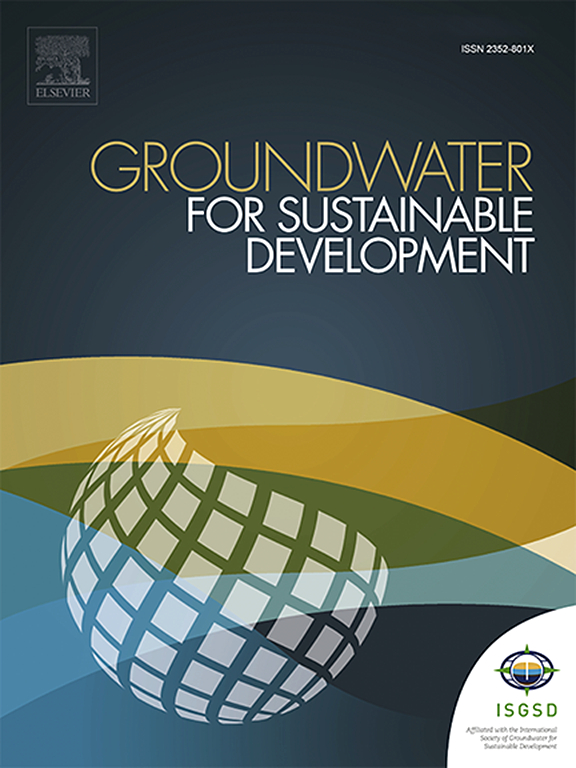Zambezi River Basin aquifer systems: Opportunities and challenges in using freely available data sources and groundwater flow modelling for spatial exploratory analysis
IF 4.9
Q2 ENGINEERING, ENVIRONMENTAL
引用次数: 0
Abstract
A groundwater flow model was implemented over the Zambezi River Basin using the state-of-the-art DHI-WASY finite element code Feflow. The analysis was based upon different freely available datasets that include a hydrologically consistent digital elevation model from HYDROSHEDS, the BGS (British Geological Survey) quantitative hydrogeological maps, and the regional hydrogeological SADC-GMI database. The model implementation was aimed at: (i) to identify and analyse challenges and limitations (data scarcity, accuracy of regional datasets, impact of geological, tectonic and hydrogeological complexity on model reliability) in applying groundwater flow modelling at basin scale; (ii) to perform an exploratory spatial analysis with reference to the magnitude and spatial distribution of effective recharge, aquifers’ properties and interlinks between surface water and aquifer systems (surface water – groundwater interactions). High uncertainty is generally associated with the estimation of hydrological and hydrogeological parameters, whose high spatial variability is not necessarily captured by the regional data products. This study evaluates how integrating freely available datasets (such as the DEM, BGS maps) influences model accuracy and uncertainty, particularly in terms of parameter estimation. The findings illustrates that, despite the limitations, freely available datasets can still effectively be used to develop a groundwater model that captures regional piezometric trends and provides insights into spatial variability. This demonstrates the potential for using such models in similar data-scarce regions. The modeling approach is expected to provide valuable quantitative insights into groundwater trends and variability, helping to identify key areas of uncertainty and guiding future data collection and model refinement efforts.

赞比西河流域含水层系统:利用可免费获得的数据源和地下水流动模型进行空间探索性分析的机遇和挑战
利用最先进的DHI-WASY有限元代码Feflow实现了赞比西河流域的地下水流动模型。该分析基于不同的免费数据集,包括来自HYDROSHEDS的水文一致性数字高程模型、BGS(英国地质调查局)定量水文地质图和区域水文地质SADC-GMI数据库。模型实施的目的是:(i)识别和分析在盆地尺度上应用地下水流动模型时面临的挑战和局限性(数据稀缺、区域数据集的准确性、地质、构造和水文地质复杂性对模型可靠性的影响);(ii)根据有效补给量的大小和空间分布、含水层的性质以及地表水和含水层系统之间的相互联系(地表水-地下水相互作用)进行探索性空间分析。高度不确定性通常与水文和水文地质参数的估计有关,这些参数的高度空间变异性不一定被区域数据产品所捕捉。本研究评估了整合免费数据集(如DEM、BGS地图)如何影响模型精度和不确定性,特别是在参数估计方面。研究结果表明,尽管存在局限性,但免费提供的数据集仍然可以有效地用于开发地下水模型,该模型可以捕获区域压力测量趋势,并提供对空间变异性的见解。这证明了在类似的数据稀缺地区使用这种模型的潜力。该建模方法有望为地下水趋势和变化提供有价值的定量见解,有助于确定关键的不确定性领域,并指导未来的数据收集和模型改进工作。
本文章由计算机程序翻译,如有差异,请以英文原文为准。
求助全文
约1分钟内获得全文
求助全文
来源期刊

Groundwater for Sustainable Development
Social Sciences-Geography, Planning and Development
CiteScore
11.50
自引率
10.20%
发文量
152
期刊介绍:
Groundwater for Sustainable Development is directed to different stakeholders and professionals, including government and non-governmental organizations, international funding agencies, universities, public water institutions, public health and other public/private sector professionals, and other relevant institutions. It is aimed at professionals, academics and students in the fields of disciplines such as: groundwater and its connection to surface hydrology and environment, soil sciences, engineering, ecology, microbiology, atmospheric sciences, analytical chemistry, hydro-engineering, water technology, environmental ethics, economics, public health, policy, as well as social sciences, legal disciplines, or any other area connected with water issues. The objectives of this journal are to facilitate: • The improvement of effective and sustainable management of water resources across the globe. • The improvement of human access to groundwater resources in adequate quantity and good quality. • The meeting of the increasing demand for drinking and irrigation water needed for food security to contribute to a social and economically sound human development. • The creation of a global inter- and multidisciplinary platform and forum to improve our understanding of groundwater resources and to advocate their effective and sustainable management and protection against contamination. • Interdisciplinary information exchange and to stimulate scientific research in the fields of groundwater related sciences and social and health sciences required to achieve the United Nations Millennium Development Goals for sustainable development.
 求助内容:
求助内容: 应助结果提醒方式:
应助结果提醒方式:


